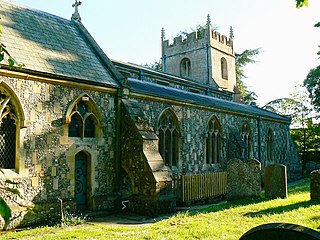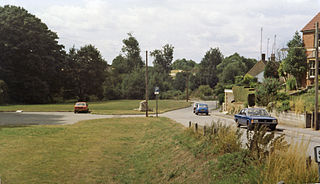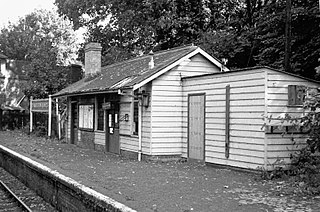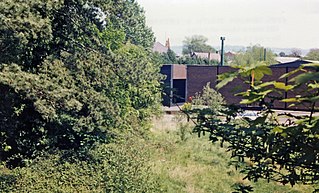
Burbage is a village and civil parish in the Vale of Pewsey, Wiltshire, England. It is about 6 miles (9.7 km) south of Marlborough and 20 miles (32 km) west of Newbury.

The Wessex Main Line is the railway line from Bristol Temple Meads to Southampton Central. Diverging from this route is the Heart of Wessex Line from Westbury to Weymouth. The Wessex Main Line intersects the Reading to Taunton Line at Westbury and the West of England Main Line at Salisbury.

Bedwyn railway station serves the village of Great Bedwyn in Wiltshire, England. It is 66 miles 33 chains from the zero point at London Paddington. Along with Pewsey station, it serves the market town of Marlborough which is 6 miles (10 km) away. A bus from the town connects with most trains on Mondays to Saturdays.
Andoversford and Dowdeswell railway station was on the Midland and South Western Junction Railway in Gloucestershire. The station opened to passengers on 1 August 1891 with the opening of the section of the line between Cirencester Watermoor and the junction at Andoversford with the Great Western Railway's Cheltenham Lansdown to Banbury line, which had opened in 1881.

Cirencester Watermoor railway station was on the Midland and South Western Junction Railway (M&SWJR) at Cirencester in Gloucestershire. The station opened on 18 December 1883, as the terminus of the Swindon and Cheltenham Extension Railway line from Swindon Town. That line then amalgamated with the Swindon, Marlborough and Andover Railway to form the M&SWJR. Cirencester became a through-station in 1891, with the opening of the northern extension of the line between Cirencester and the junction at Andoversford with the Great Western Railway (GWR)'s Cheltenham Lansdown to Banbury line, which had opened in 1881.

South Cerney railway station was on the Midland and South Western Junction Railway in Gloucestershire. The station opened on 18 December 1883 on the Swindon and Cheltenham Extension Railway line from Swindon Town to the temporary terminus at Cirencester Watermoor. The S&CER line amalgamated in 1884 with the Swindon, Marlborough and Andover Railway to form the M&SWJR, and through services beyond Cirencester to the junction at Andoversford with the Great Western Railway's Cheltenham Lansdown to Banbury line, which had opened in 1881, started in 1891.
Cricklade railway station was on the Midland and South Western Junction Railway in Wiltshire, England. The station opened on 18 December 1883 on the Swindon and Cheltenham Extension Railway line from Swindon Town to the temporary terminus at Cirencester Watermoor. The S&CER line then amalgamated with the Swindon, Marlborough and Andover Railway to form the M&SWJR, and through services to the junction at Andoversford with the Great Western Railway's Cheltenham Lansdown to Banbury line, which had opened in 1881, began in 1891.

Rushey Platt railway station is a former station on the Midland and South Western Junction Railway at Rushey Platt, south west of the centre of Swindon in Wiltshire.

Swindon Town railway station was on the Midland and South Western Junction Railway at Swindon in Wiltshire. The station was sited in the Old Town area about one-and-a-half miles from the Great Western Railway's Swindon Junction.

Chiseldon railway station was on the Midland and South Western Junction Railway in Wiltshire.

Chiseldon Camp Halt was a small railway station on the Midland and South Western Junction Railway line, south of Swindon in Wiltshire, England.

Ogbourne railway station was on the Midland and South Western Junction Railway in Wiltshire, England. The station opened on 27 July 1881 on the Swindon Town to Marlborough section of the Swindon, Marlborough and Andover Railway. In 1883, a northwards extension, the Swindon and Cheltenham Extension Railway, opened from Swindon Town to Cirencester Watermoor, with further northward extension to a junction with the Great Western Railway's Cheltenham to Banbury line near Andoversford opening in 1891, enabling through trains from the Midlands to the south, through Ogbourne. The SM&AR and the S&CER had in 1884 amalgamated to form the M&SWJR.

Charlton Kings railway station was a small station in Gloucestershire serving the village of Charlton Kings and the southern outskirts of Cheltenham Spa.

Cheltenham Leckhampton railway station in Gloucestershire served the village of Leckhampton and the southern outskirts of Cheltenham Spa.

Grafton and Burbage railway station served the villages of Burbage and East and West Grafton in Wiltshire, England. The station was on the Midland and South Western Junction Railway. It opened in May 1882 as the northern terminus of the southern section of the Swindon, Marlborough and Andover Railway and became a through station when the line from Swindon was completed through a new Marlborough station and the Great Western Railway's Savernake station in February 1883.

Collingbourne railway station served the village of Collingbourne Ducis in Wiltshire, England. It was on the Midland and South Western Junction Railway (M&SWJR) and opened on 1 May 1882 on the southern section of the Swindon, Marlborough and Andover Railway (SM&AR) which at that stage terminated at the-then next station to the north, Grafton and Burbage. In 1883, the SM&AR gained running rights over the Great Western Railway branch from Savernake Low Level to Marlborough and through services started between Swindon Town and Andover Junction railway station, and on down the Sprat and Winkle Line to Southampton. The same year, the Swindon and Cheltenham Extension Railway (S&CER) opened north of Swindon as far as Cirencester and in 1884 the SM&AR and the S&CER merged to form the M&SWJR. The line was completed as a through-route from the Midlands to the south coast by the completion of the northern end of the route between Cirencester and Cheltenham in 1891.
The Midland and South Western Junction Railway (M&SWJR) was an independent railway built to form a north–south link between the Midland Railway and the London and South Western Railway in England, allowing the Midland and other companies' trains to reach the port of Southampton. The M&SWJR was formed in 1884 from the amalgamation of the Swindon, Marlborough and Andover Railway and the Swindon and Cheltenham Extension Railway. The line was absorbed by the Great Western Railway at the 1923 grouping of the railways, and became part of British Railways on nationalisation in 1948. The railway closed to passengers in 1961, and to goods between 1964 and 1970. A small part of it has been reopened as the heritage Swindon and Cricklade Railway.

Holt Junction was a railway station which served the village of Holt, Wiltshire, England between 1861 and 1966. It stood on the Wessex Main Line at its junction with the western end of the Devizes branch.

Savernake Low Level railway station was a station on the Berks and Hants Extension Railway, near the village of Burbage in Wiltshire, England. It was open from 1862 until 1966.

Ludgershall railway station was a railway station which served the town of Ludgershall in Wiltshire, England from 1882 to 1961.



















